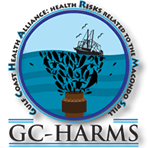The Gulf Coast Health Alliance: health Risks related to the Macondo Spill (GC-HARMS)
 The Gulf Coast Health Alliance: health Risks related to the Macondo Spill (GC-HARMS), study was a project funded by the National Institute of Environmental Health Sciences after the explosion of the Deepwater Horizon (DWH) in 2010 and subsequent oil
spill. UTMB worked with Gulf Coast fishing communities to measure petroleum-related polycyclic aromatic hydrocarbons (PAHs) in local seafood and determine potential health effects over time. The GC-HARMS project consortium included four academic
institutions and six community groups and was led by UTMB. GC-HARMS represented a Community-Based Participatory Research approach to the science. Community involvement includes:
The Gulf Coast Health Alliance: health Risks related to the Macondo Spill (GC-HARMS), study was a project funded by the National Institute of Environmental Health Sciences after the explosion of the Deepwater Horizon (DWH) in 2010 and subsequent oil
spill. UTMB worked with Gulf Coast fishing communities to measure petroleum-related polycyclic aromatic hydrocarbons (PAHs) in local seafood and determine potential health effects over time. The GC-HARMS project consortium included four academic
institutions and six community groups and was led by UTMB. GC-HARMS represented a Community-Based Participatory Research approach to the science. Community involvement includes:
- Helping to shape research questions and design methods that aligned with community needs and relied upon community expertise to advise study methods
- Active participation in the collection of seafood samples for analysis of PAHs
- Local management of the study protocol, recruiting participants, developing and translating study questionnaires, coordinating logistics, and disseminating study results
Background
In the aftermath of the spill at the behest of communities who had been directly or indirectly impacted, UTMB staff either met face-to-face or via telephone with 26 nonprofit environmental organizations in Louisiana,
Mississippi, Alabama, and Texas to identify potential research priorities and gauge interest in participating in a long-term study examining human health effects related to the spill. This work led to the development of a research consortium and began
to shape the group’s research direction and approach. In 2011, the GC-HARMS project was awarded NIEHS funding as part of a DWH Research Consortia program. Under GC-HARMS, community partner organizations (community “hubs”), local
fishermen, and their families participated in two separate data collection initiatives – a seafood sampling study to assess the PAH toxicity of locally-caught seafood, and a human health study of potential effects from exposure to PAHs through
seafood consumption. The Alliance is a coalition of academic institutions and local organizations that were either directly or indirectly impacted by the Macondo Spill, including:
- UTMB
- University of Pennsylvania
- Texas A&M at Galveston
- Louisiana State University
- Louisiana Environmental Action Network
- Center for Environmental and Economic Justice
- Vietnamese American Community Partners
- United Houma Nation
- Alabama Fisheries Cooperative
- Bayou Interfaith Shared Community Organizing
The goals of GC-HARMS were to:
1. Assess seafood contamination,
2. Determine PAH toxicity,
3. Evaluate exposure and health outcomes in a longitudinal cohort study, and
4. Disseminate findings to stakeholders.
Seafood Sampling Study
UTMB scientists worked with the Louisiana Environmental Action Network (LEAN) and consultant Wilma Subra to develop a seafood sampling protocol and a training curriculum for fishermen. UTMB staff and
community hub coordinators also implemented a series of Fishermen’s Forums, which aimed to recruit local fishermen and raise awareness of the GC-HARMS project. More than 200 fishermen and other residents from targeted coastal communities in Louisiana,
Mississippi, and Alabama attended the Fishermen’s Forums, and 52 of the fishermen agreed to participate in the seafood sampling study.
The fishermen’s local knowledge of consumption practices and their observations regarding changes in fish species in oil-impacted locations were integral to determining sampling site locations. In total, area fishermen collected thousands
of samples of shrimp, blue crab, oysters, and a variety of finfish from 208 sites during a three-year sampling period.
Human Health Study
GC-HARMS community partners worked closely with university researchers throughout all stages of the human health study. Community hubs played vital roles selecting and recruiting participants,
developing and translating study questionnaires, coordinating logistics, and disseminating the results. Four hundred individuals were randomly selected to participate in the study – 100 members from each of three fishing communities in Mississippi
and Louisiana, and 100 residents from a comparison community in Galveston, Texas, not directly affected by the oil spill.
Outcomes
Seafood Consumption Calculator: https://www.utmb.edu/scg/
Seafood Sampling Matrix Map: http://gcharms.leanweb.org/seafood-sampling-map/